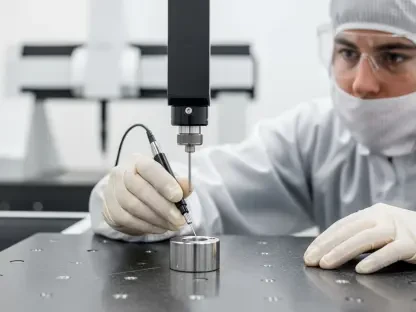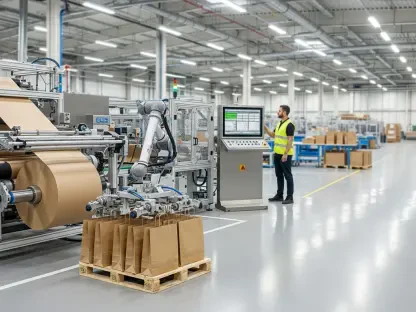The Niobium Isopropoxide market is emerging as a critical component in the realm of high-tech industries, with projections estimating a remarkable climb from a valuation of USD 246.97 billion in 2024 to an impressive USD 448.2 billion by 2032. This organometallic compound, often recognized for its colorless to pale yellow appearance and high reactivity, serves as a vital precursor in crafting advanced materials such as niobium-based oxides and catalysts. Its applications stretch across cutting-edge fields like chemical vapor deposition (CVD), thin-film production, and high-performance ceramics, making it indispensable in sectors like electronics and renewable energy. With a consistent compound annual growth rate (CAGR) of 7.73%, this market is a testament to the increasing reliance on innovative solutions to meet the demands of a technology-driven era. As industries push for greater efficiency and miniaturization, the significance of niobium isopropoxide only intensifies. But what are the key forces propelling this upward trajectory, and what obstacles might hinder progress along the way? This exploration aims to uncover the dynamics shaping the market’s path over the coming years.
Forces Fueling Market Expansion
The surge in the Niobium Isopropoxide market is largely driven by robust demand from the electronics and semiconductor industries, where the need for smaller, more efficient devices has become paramount. This compound is crucial in processes like thin-film deposition and coatings, enabling the creation of components that meet stringent performance standards. As consumer electronics continue to evolve with rapid advancements, manufacturers increasingly turn to niobium isopropoxide to ensure precision and reliability in their products. Beyond consumer goods, its role in industrial applications further solidifies its importance, as it supports the development of cutting-edge technologies that power modern infrastructure. The push for innovation in this space not only highlights the compound’s versatility but also underscores its growing relevance in a competitive global market.
Another significant driver is the renewable energy sector’s escalating reliance on niobium isopropoxide for producing materials essential to sustainable solutions. From solar cells to lithium-ion batteries, the compound is integral to enhancing energy storage and conversion efficiencies, aligning with global efforts to transition to greener technologies. Additionally, breakthroughs in nanotechnology and materials science have expanded its utility, particularly in creating high-performance ceramics and nanoparticles for specialized applications. Research and development efforts continue to uncover new uses, supported by substantial investments aimed at refining processes like sol-gel and CVD. These advancements reduce production costs and improve accessibility, further accelerating market growth. The intersection of technological progress and environmental priorities positions niobium isopropoxide as a linchpin in shaping a sustainable industrial future.
Barriers to Widespread Adoption
Despite its promising outlook, the Niobium Isopropoxide market faces considerable challenges that could impede its broader acceptance across industries. One of the most pressing issues is the high cost associated with niobium compounds and the raw materials required for production, such as niobium and isopropanol. These expenses create a significant hurdle, particularly for companies aiming to scale operations without compromising profitability. Fluctuations in raw material prices add another layer of uncertainty, making it difficult for manufacturers to predict and manage budgets effectively. This financial strain often discourages smaller players from entering the market, limiting overall expansion and innovation in applications where cost efficiency is a priority.
Further complicating matters are the compound’s inherent properties and the regulatory landscape surrounding its use. Niobium isopropoxide’s extreme sensitivity to moisture necessitates specialized handling and storage facilities, which drive up operational expenses and logistical complexities. Moreover, stringent regulations governing organometallic compounds impose additional compliance costs and restrict market access in certain regions, slowing down adoption rates. Awareness remains limited in emerging economies, where industries may lack the technical expertise or resources to integrate such advanced materials into their workflows. Competition from more affordable alternative precursors also poses a threat, as cost-sensitive sectors might opt for substitutes, potentially diverting demand and challenging the compound’s market share.
Emerging Prospects for Growth
On the flip side, the Niobium Isopropoxide market is ripe with opportunities that could catalyze significant expansion in the years leading to 2032. Emerging markets, particularly in the Asia-Pacific region, stand out as hotspots for growth due to rapid industrialization and a burgeoning appetite for technology adoption. As these regions invest heavily in semiconductor manufacturing and renewable energy projects, the demand for advanced materials like niobium isopropoxide is expected to rise sharply. This trend offers a substantial opportunity for chemical manufacturers to tap into new customer bases, provided they can address local infrastructure and awareness gaps through targeted education and investment initiatives.
Sustainability trends also present a compelling avenue for market development, as industries increasingly prioritize eco-friendly practices in material production. The push for green synthesis methods and low-volatile organic compound (VOC) derivatives of niobium isopropoxide aligns with global environmental goals, attracting interest from manufacturers committed to reducing their ecological footprint. Strategic collaborations between chemical producers, technology firms, and academic institutions further enhance growth prospects by fostering innovation and expanding application scopes. The growing emphasis on nanotechnology research adds another dimension, with the compound finding high-value uses in catalysts and nanostructured materials. By leveraging these opportunities, stakeholders can transform potential into tangible market gains.
Navigating the Future Landscape
Looking ahead, the Niobium Isopropoxide market stands at a critical juncture, with its projected growth reflecting both immense potential and persistent challenges. The path from a valuation of USD 246.97 billion in 2024 to USD 448.2 billion by 2032 is shaped by robust demand from electronics and energy sectors, even as high costs and regulatory constraints test industry resilience. Historical barriers like moisture sensitivity and limited awareness in emerging regions demand innovative solutions and strategic outreach, which many companies have tackled through targeted R&D investments. Reflecting on past efforts, it’s clear that overcoming these hurdles requires a blend of technological ingenuity and market adaptability.
To sustain momentum, stakeholders must focus on actionable strategies that address lingering issues while capitalizing on untapped potential. Investing in cost-effective production techniques and sustainable formulations will be crucial to broadening access across diverse markets. Building partnerships to enhance distribution networks and technical know-how in underdeveloped regions can unlock new growth frontiers. Additionally, staying ahead of regulatory shifts through proactive compliance measures will ensure smoother market entry. As the industry moves forward, prioritizing these steps will not only solidify niobium isopropoxide’s role in high-tech applications but also pave the way for enduring success in an ever-evolving global landscape.









